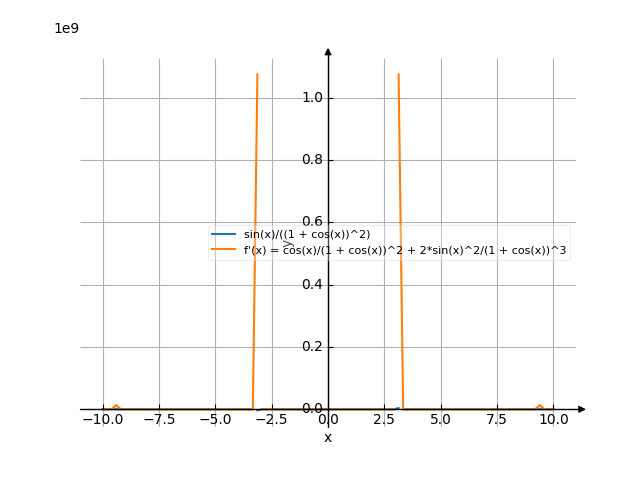Derivative of y=sinx/(1+cosx)²
The solution
You have entered
[src]
sin(x)
-------------
2
(1 + cos(x))
$$\frac{\sin{\left(x \right)}}{\left(\cos{\left(x \right)} + 1\right)^{2}}$$
d / sin(x) \ --|-------------| dx| 2| \(1 + cos(x)) /
$$\frac{d}{d x} \frac{\sin{\left(x \right)}}{\left(\cos{\left(x \right)} + 1\right)^{2}}$$
Detail solution
-
Apply the quotient rule, which is:
and .
To find :
-
The derivative of sine is cosine:
To find :
-
Let .
-
Apply the power rule: goes to
-
-
Then, apply the chain rule. Multiply by :
-
Differentiate term by term:
-
The derivative of the constant is zero.
-
The derivative of cosine is negative sine:
The result is:
-
The result of the chain rule is:
-
Now plug in to the quotient rule:
Now simplify:
The answer is:
The first derivative
[src]
2
cos(x) 2*sin (x)
------------- + -------------
2 3
(1 + cos(x)) (1 + cos(x))
$$\frac{\cos{\left(x \right)}}{\left(\cos{\left(x \right)} + 1\right)^{2}} + \frac{2 \sin^{2}{\left(x \right)}}{\left(\cos{\left(x \right)} + 1\right)^{3}}$$
The second derivative
[src]
/ / 2 \ \
| |3*sin (x) | |
| 2*|---------- + cos(x)| |
| \1 + cos(x) / 4*cos(x) |
|-1 + ----------------------- + ----------|*sin(x)
\ 1 + cos(x) 1 + cos(x)/
--------------------------------------------------
2
(1 + cos(x))
$$\frac{\left(-1 + \frac{2 \left(\cos{\left(x \right)} + \frac{3 \sin^{2}{\left(x \right)}}{\cos{\left(x \right)} + 1}\right)}{\cos{\left(x \right)} + 1} + \frac{4 \cos{\left(x \right)}}{\cos{\left(x \right)} + 1}\right) \sin{\left(x \right)}}{\left(\cos{\left(x \right)} + 1\right)^{2}}$$
The third derivative
[src]
/ 2 \
2 | 9*cos(x) 12*sin (x) | / 2 \
2*sin (x)*|-1 + ---------- + -------------| |3*sin (x) |
2 | 1 + cos(x) 2| 6*|---------- + cos(x)|*cos(x)
6*sin (x) \ (1 + cos(x)) / \1 + cos(x) /
-cos(x) - ---------- + ------------------------------------------- + ------------------------------
1 + cos(x) 1 + cos(x) 1 + cos(x)
---------------------------------------------------------------------------------------------------
2
(1 + cos(x))
$$\frac{\frac{2 \left(-1 + \frac{9 \cos{\left(x \right)}}{\cos{\left(x \right)} + 1} + \frac{12 \sin^{2}{\left(x \right)}}{\left(\cos{\left(x \right)} + 1\right)^{2}}\right) \sin^{2}{\left(x \right)}}{\cos{\left(x \right)} + 1} - \cos{\left(x \right)} + \frac{6 \left(\cos{\left(x \right)} + \frac{3 \sin^{2}{\left(x \right)}}{\cos{\left(x \right)} + 1}\right) \cos{\left(x \right)}}{\cos{\left(x \right)} + 1} - \frac{6 \sin^{2}{\left(x \right)}}{\cos{\left(x \right)} + 1}}{\left(\cos{\left(x \right)} + 1\right)^{2}}$$
The graph


![Find the derivative of y' = f'(x) = y=sinx/(1+cosx)² (y equally sinus of x divide by (1 plus co sinus of e of x)²) - functions. Find the derivative of the function at the point. [THERE'S THE ANSWER!] y=sinx/(1+cosx)²](/media/krcore-image-pods/176/hash/derivative/e/30/17edac30ae722ba46bc5924a985ad.png)
 Derivative of 5*x^4-7*x^2-x
Derivative of 5*x^4-7*x^2-x
 Derivative of 3x-ln(x+3)^3
Derivative of 3x-ln(x+3)^3
 Derivative of 3*e^(2*x)
Derivative of 3*e^(2*x)
 Derivative of 2^x*cos(x)
Derivative of 2^x*cos(x)